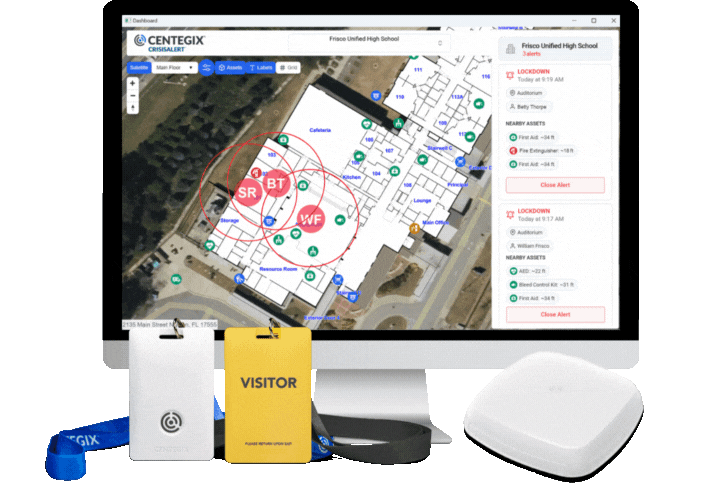Healthcare employees in the U.S. face demanding and often dangerous conditions, including violence from patients, families, and visitors. Since the pandemic, healthcare workers have experienced amplified stress with long hours, heavy workloads, and staffing shortages. These factors led to a spike in incidents of workplace violence in healthcare settings and many healthcare workers feeling unsafe at work. As a response, healthcare organizations are exploring new technologies, such as the wearable duress button, to reduce violence and enhance employee safety. However, implementing new technologies raises concerns about maintaining a balance between employee safety and privacy.
Healthcare Adoption of Real-time Locating Systems
In response to increased rates of violence in healthcare, many organizations have implemented additional security measures to help mitigate and prevent harm to staff. Technologies like wearable duress buttons are becoming more common in hospitals and other patient care facilities. Duress buttons allow staff to summon help immediately if encountering a potentially threatening situation. These duress buttons often feature real-time locating systems (RTLS) that alert responders to the exact location of the emergency.
However, not all wearable duress buttons use locating technology in the same way, and in their efforts to enhance safety, many RTLS track hospital staff throughout their day. In these cases, leaders must balance concerns about the privacy and security of employees while implementing this new technology. To ensure employee privacy is protected, the Federal Trade Commission recommends healthcare leaders consider the following steps:
- Know what personal information is being collected.
- Scale down the information being collected.
- Protect the information that needs to be collected.
- Ensure proper disposal of information not needed.
- Create a plan for when security incidents occur.
Don’t Sacrifice Privacy for Safety
A reliable safety platform and wearable duress button technology can provide precise location details so responders know exactly where their help is needed when an emergency strikes and what safety assets are available in surrounding areas. However, since some duress button providers constantly track nurses and other healthcare personnel throughout their shifts, many staff feel this technology leads to privacy infringement and sacrifices privacy for safety.
For this reason, real-time locating system (RTLS) technology is currently at the forefront of privacy discussions in healthcare. Research shows that hospital staff who express personal privacy and data use concerns about RTLS are less likely to adopt and implement the technology effectively. In some cases, hospitals have documented cases where clinical staff have even sabotaged their equipment due to privacy concerns. Many studies of RTLS implementation rates in hospitals document that privacy remained a persistent concern for staff and consistently inhibited proper implementation of the safety technology.
Clearly, workers shouldn’t be made to feel like their employer is watching or using their data incorrectly, and unions don’t want their members’ privacy invaded by constant location tracking. Unfortunately, concerns around privacy and trust can exacerbate burnout in staff who already feel under-supported, leading to higher rates of employee turnover.
The CENTEGIX Safety Platform™ features a CrisisAlertTM wearable duress button that activates cutting-edge locating technology only when the user requests help. This type of activation mitigates privacy concerns while still collecting the necessary information for an accelerated response to a crisis. There are many benefits to managing locating abilities in this way. Users can feel protected without feeling tracked or constantly watched. Also, the CrisisAlert battery life is significantly extended by not continually tracking, so its user doesn’t need to remember to charge the badge or turn it in at the end of a shift. CrisisAlert empowers your staff to request help only when needed and allows healthcare workers to feel safer at work without being tracked throughout the day.
Nancy Shendell-Falik, former President and Senior Vice President of Operations at Baystate Health, describes the CrisisAlert duress button as a “quick” way to get help. “Being safe, whether physically or psychologically, is foundational to being able to provide patient care. The CrisisAlert duress badge is a game changer. This allows help when it’s most needed and enables a quick response.”
The CENTEGIX Safety Platform gathers crucial data to help hospitals make informed decisions about violence prevention. The software provides leadership with insights into areas with the highest incidence of violence, enabling strategic reallocation of staff and resources. By identifying hotspots like psychiatric units, recovery wings, and emergency rooms, you can proactively prevent incidents before they occur.
Protect Your Nursing Staff with CENTEGIX®
Evaluating safety technology can be extremely stressful—but it doesn’t have to be. CENTEGIX provides healthcare organizations with tools to keep their workforce safe, without compromising privacy. The CrisisAlert wearable duress button does NOT track staff but rather locates them in times of an active crisis, ensuring their privacy remains protected while providing help when needed.
The CENTEGIX Safety Platform is an advanced hospital safety solution designed to create a culture centered around safety, improving retention and reducing turnover. The CENTEGIX Safety Platform offers precise locating capabilities to ensure an accelerated and effective response during moments of need.
The Safety Platform at a glance:
- Discreet, one-button wearable duress badge
- Total campus coverage, including parking lots and garages
- Precise locating capabilities activated only by the user
- Private Bluetooth network, so no Wi-Fi or cellular service is required to send an alert
- Digital mapping to outline floorplans, incident locations, and safety assets
- Easy installation, with no hardwiring required
- Accessible and automatic reporting collected within an easy-to-use dashboard
- OSHA, CMS, and JC compliant
The CENTEGIX Safety Platform offers a multi-pronged solution to enhance safety in your facility. The CENTEGIX Safety Platform can secure every square foot of hospital property without Wi-Fi and cellular dead zones. Hospital staff can request help anywhere on campus, from secure ORs to parking lots, with no Wi-Fi or cell service required.
The CENTEGIX CrisisAlert wearable duress button provides an easy, discreet way for staff to request help while they simultaneously leverage their de-escalation training. With precise location accuracy, responders know exactly where to dispatch help. Whether staff are providing care in patient rooms, working in the emergency bay, or walking in the parking garage, CENTEGIX CrisisAlert delivers full-campus coverage for your staff. CENTEGIX CrisisAlert can be installed with no alterations to physical structure or electrical wiring, and installation can be completed with minimal disruption to patient care.
CENTEGIX Safety Blueprint™ provides hospitals with digital, multi-layered maps of their campuses—including information about safety assets—which is invaluable for staff and responders in high-stress emergencies. CENTEGIX Safety Blueprint is highly customizable, so hospitals have a solution tailored to their needs.
CENTEGIX Visitor Management enhances the supervision of hospital traffic for administrators. Enhanced Visitor Management is capable of locating all guests, volunteers, and contractors in real-time through live digital maps. It also records visitor details for future reference.
CENTEGIX aims to lessen the burden related to workplace safety, empowering your staff to focus on what they do best—caring for patients. Accessible and automatic reporting facilitates collaboration between departments within the healthcare setting so that everyone is working from the same foundational information to make data-driven decisions.
Balancing Safety and Privacy with CENTEGIX
The uptick in workplace violence in healthcare means every second matters but providing the highest level of safety for your employees should not have to be at the expense of their safety. You can set your healthcare organization up for success by partnering with CENTEGIX and utilizing technology that balances both priorities.
CENTEGIX is an industry leader in wearable safety technology, with over 600,000 badges in use. Leaders in over 12,000 locations nationwide trust CENTEGIX’s innovative safety solutions to empower and protect their people.
Click here to see how wearable duress button technology can help you create a culture of safety in your healthcare facility without sacrificing employee privacy.












